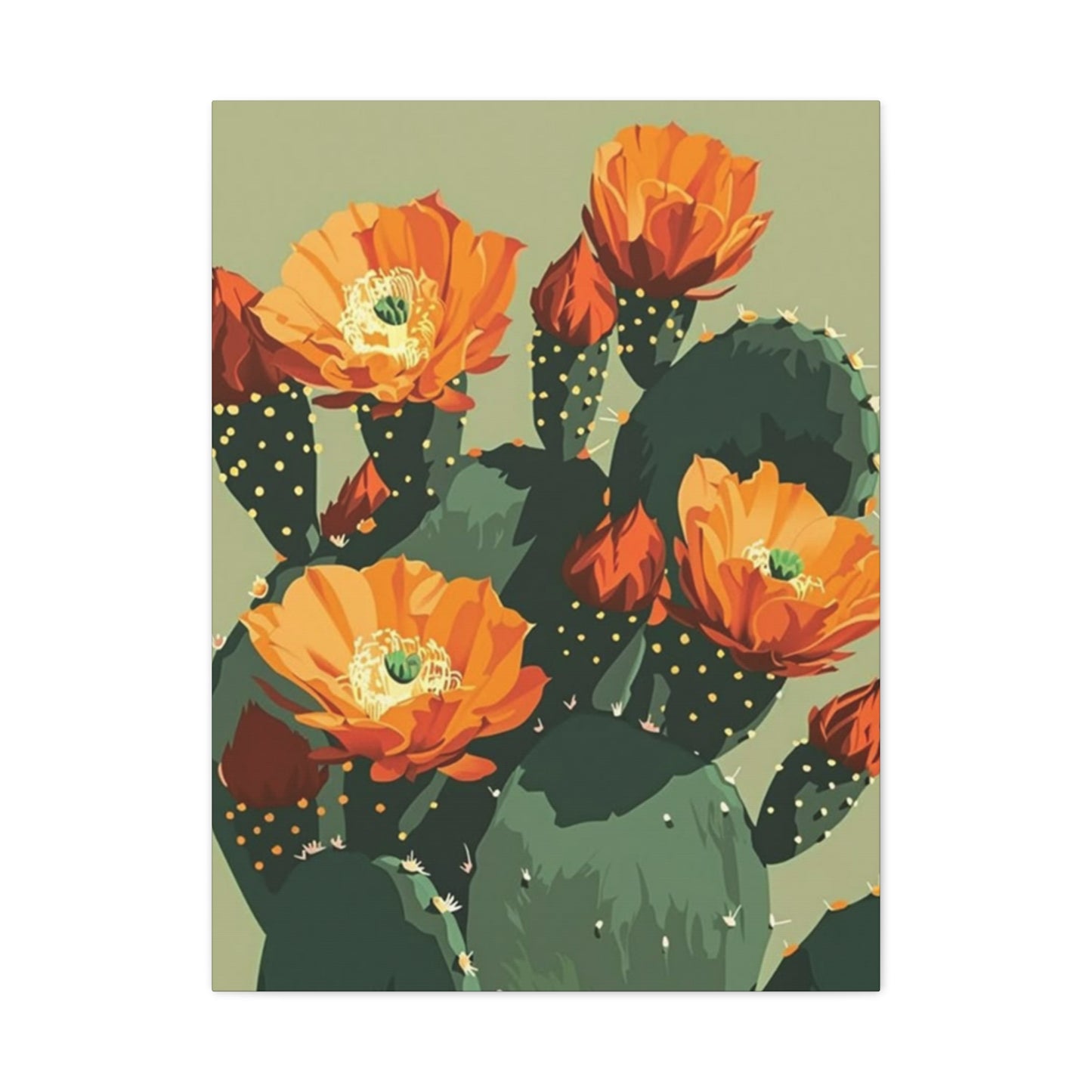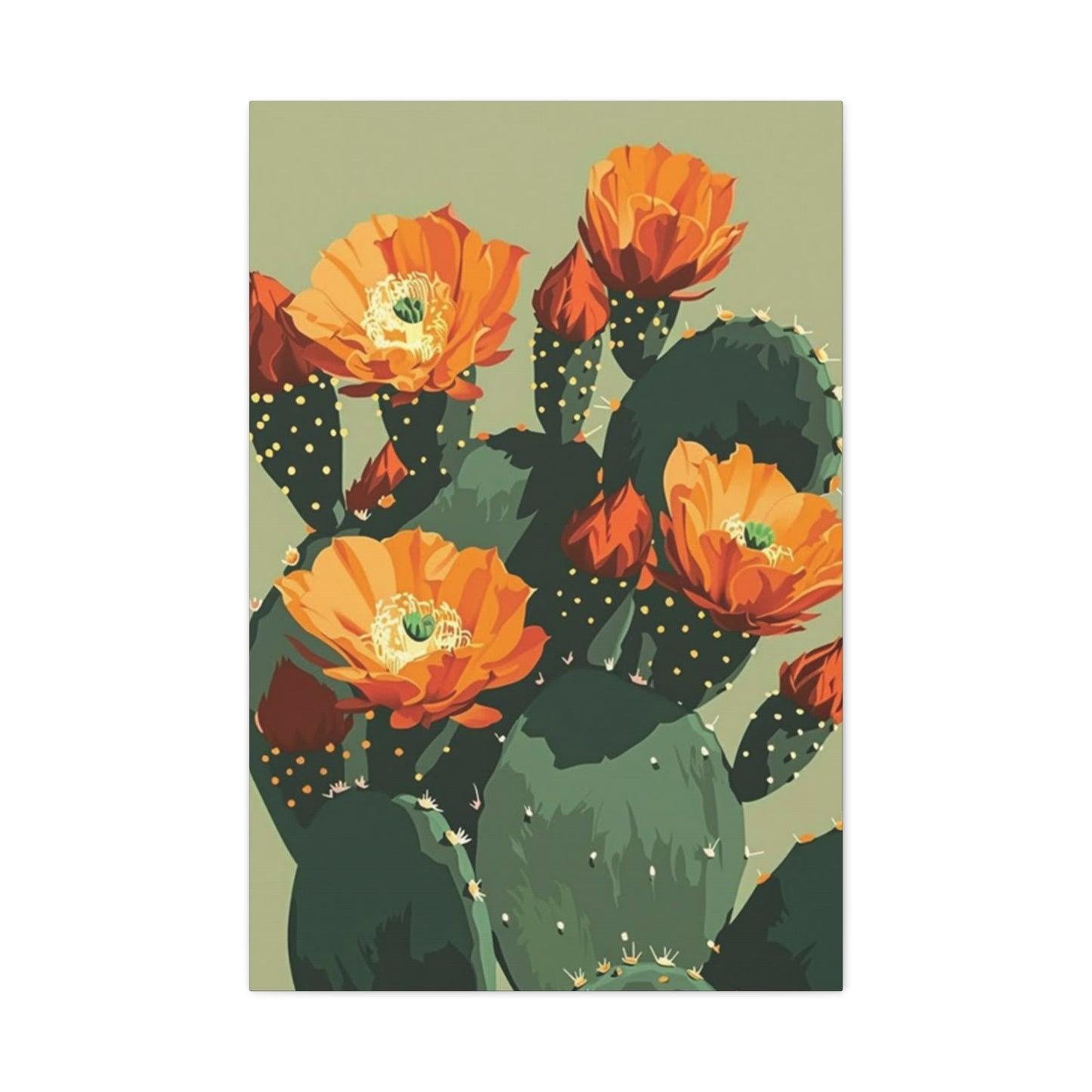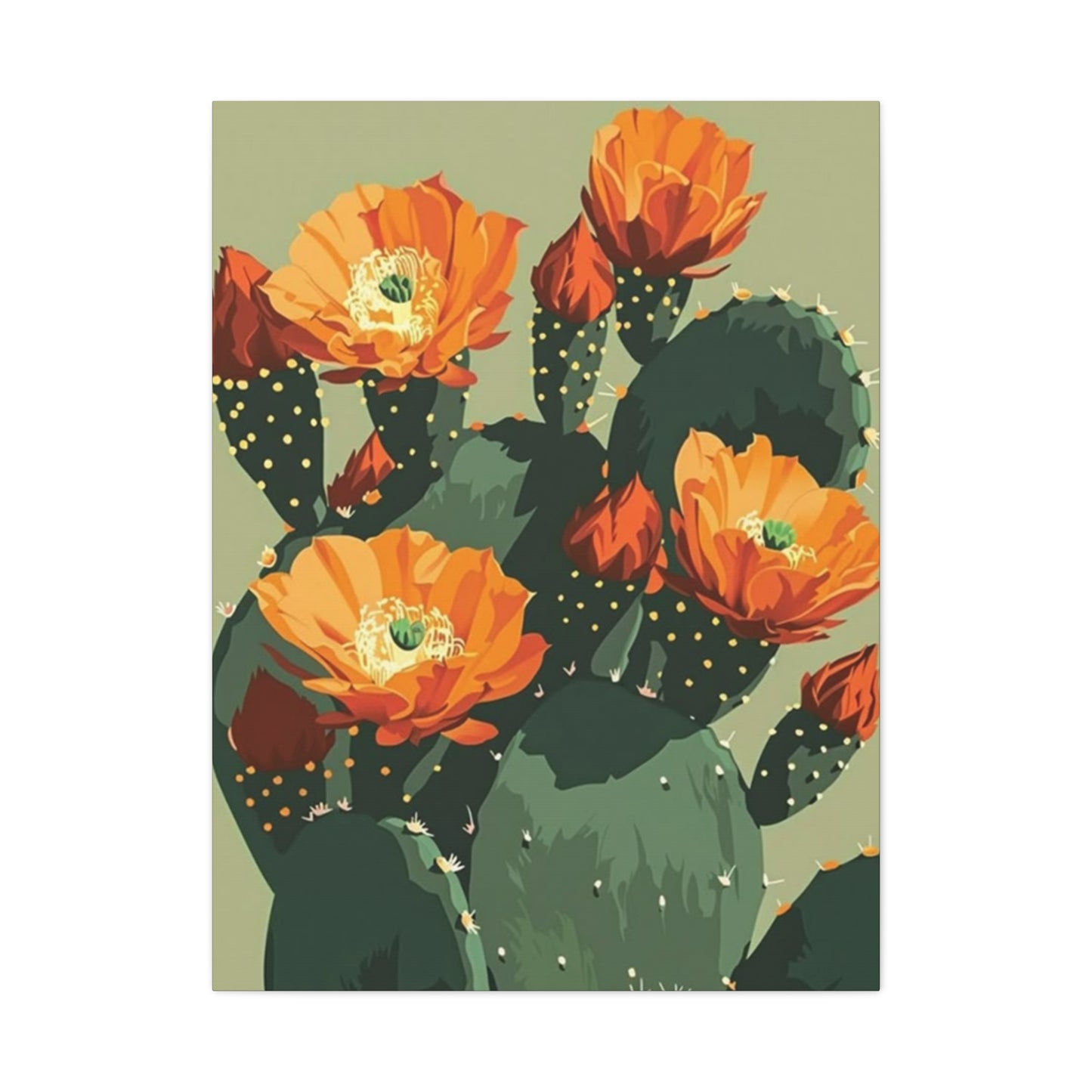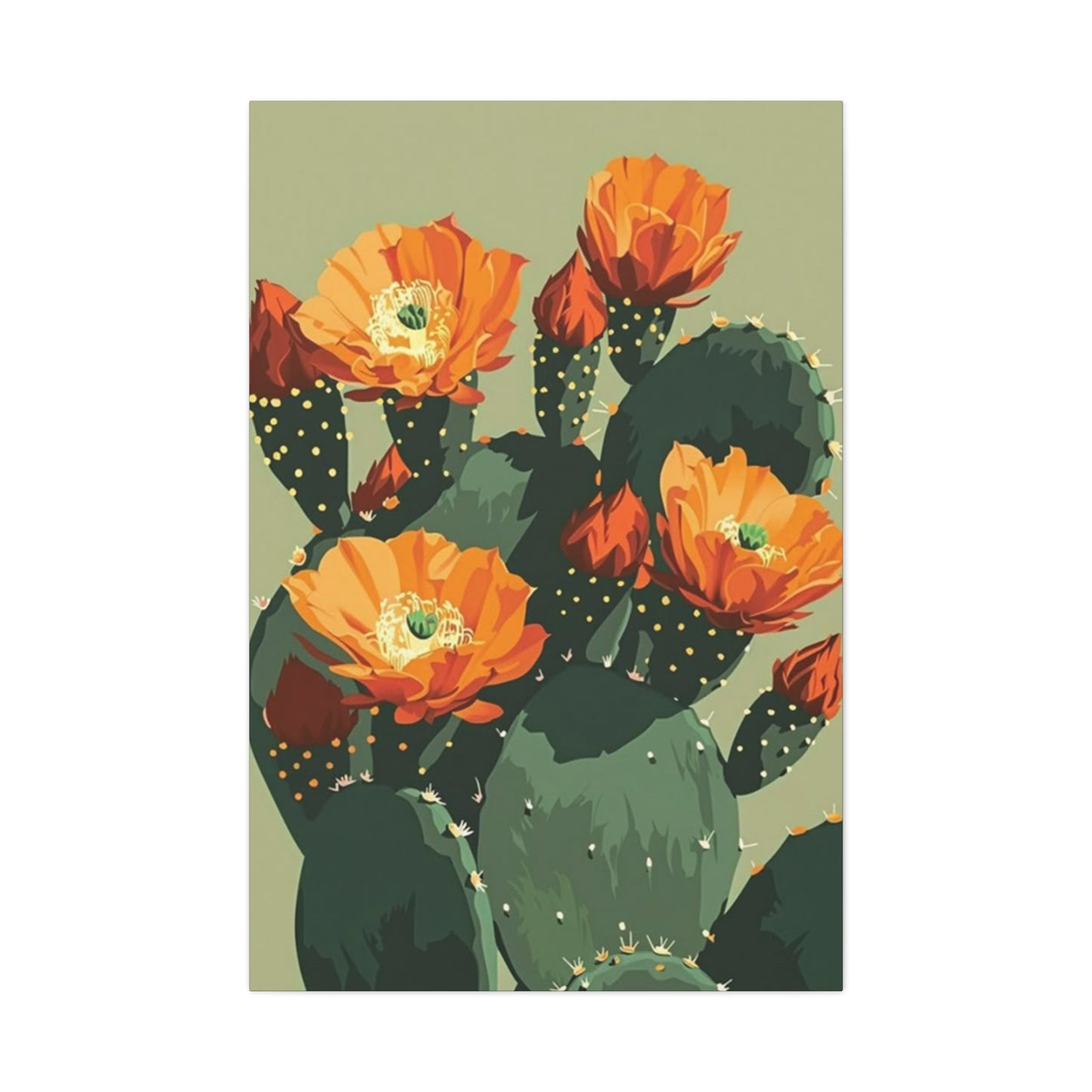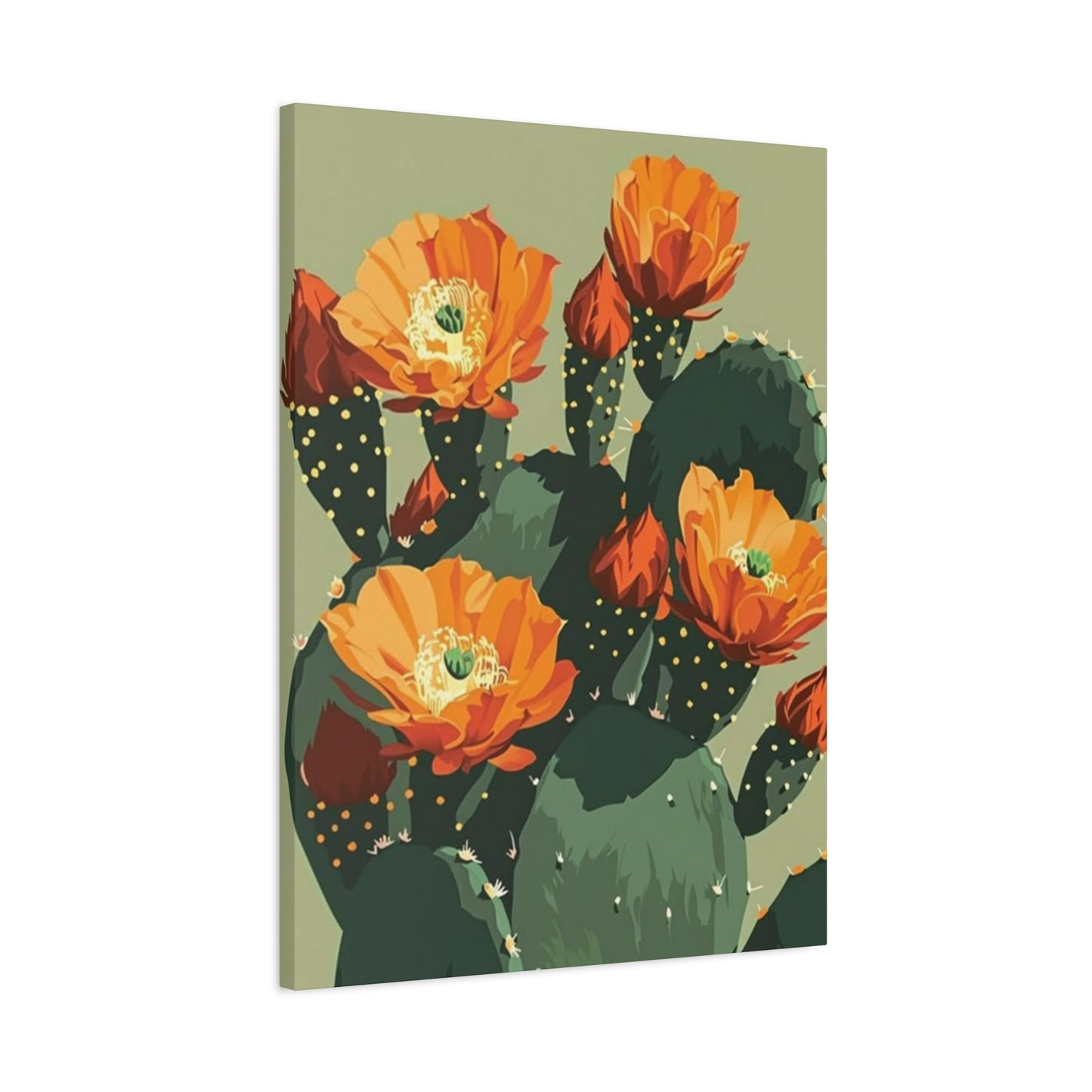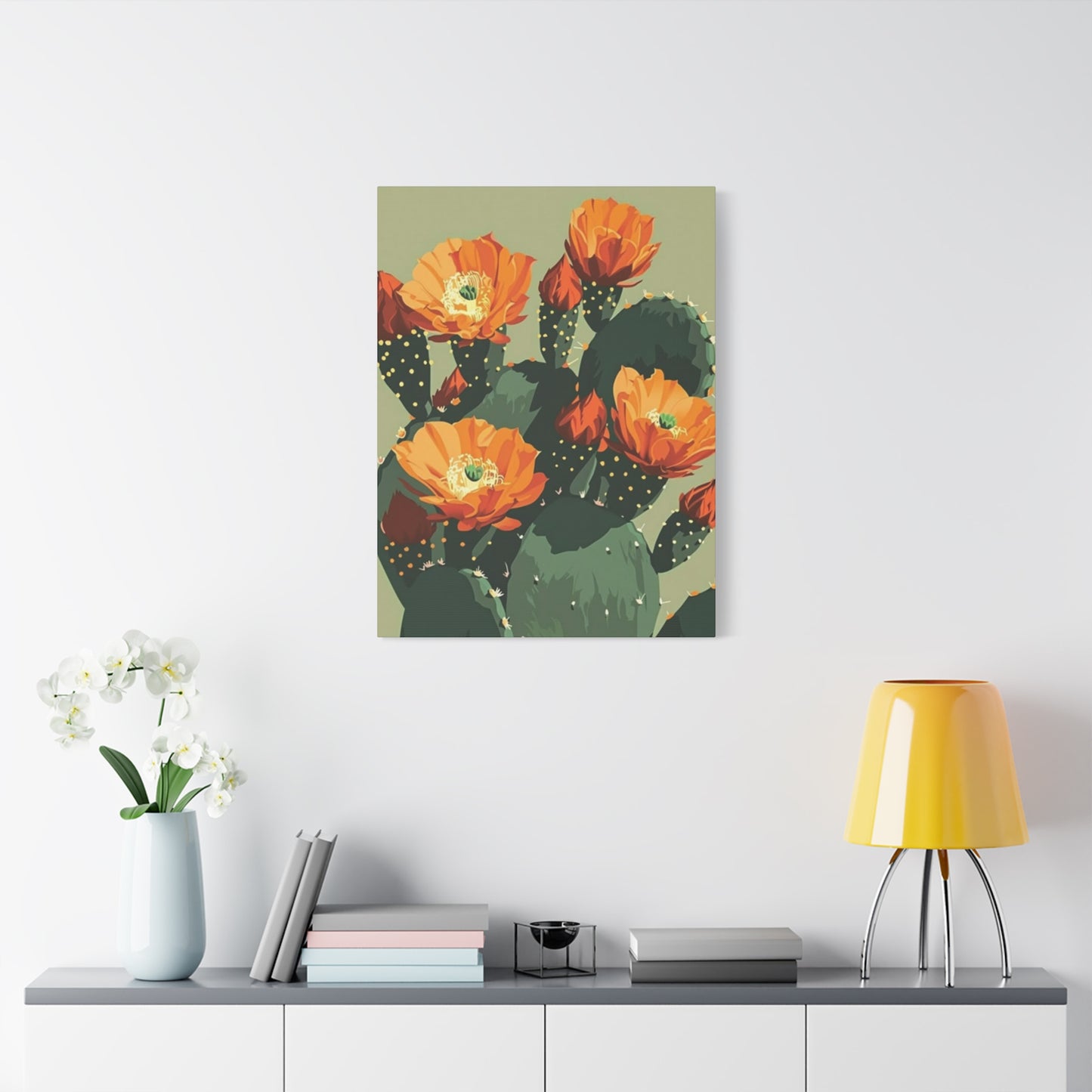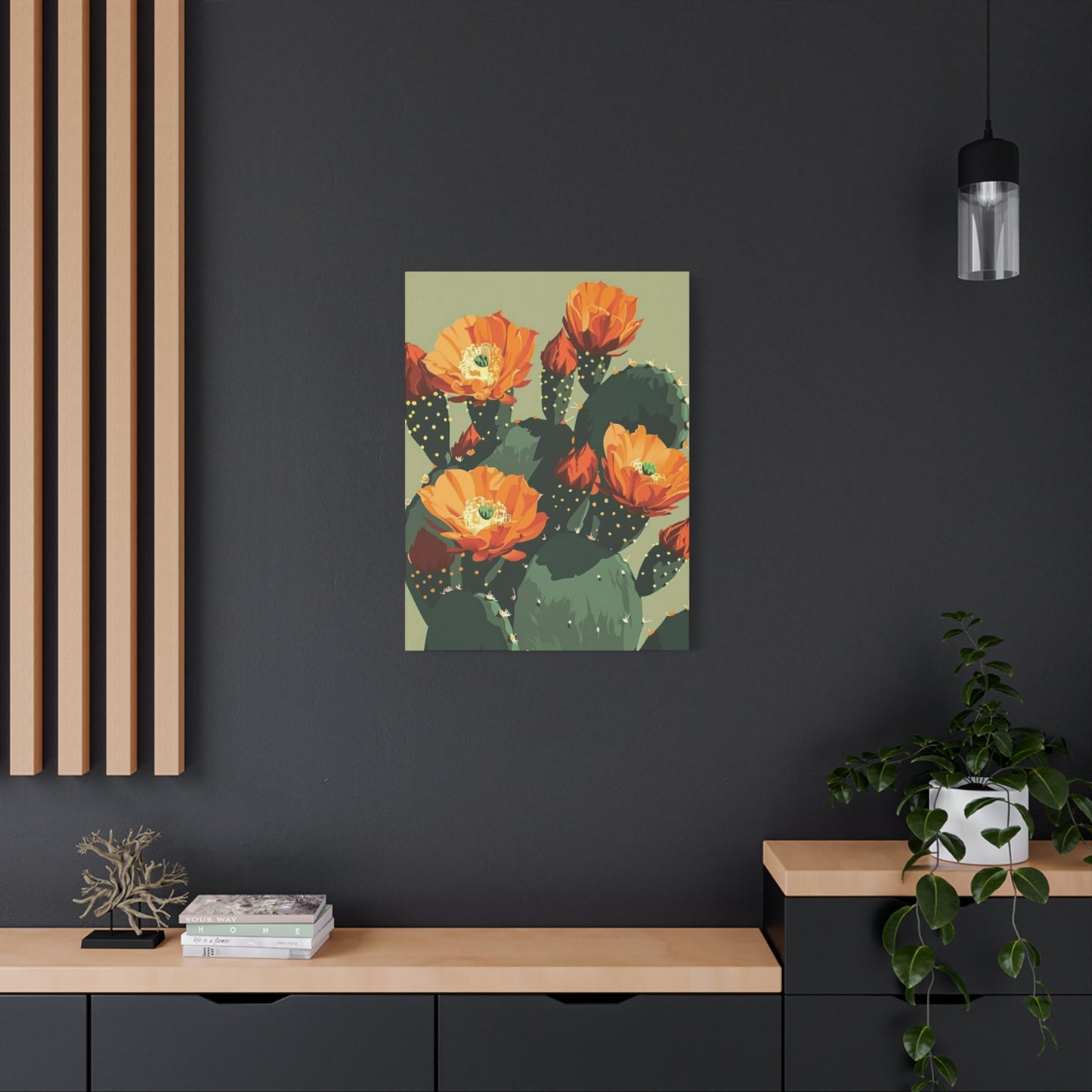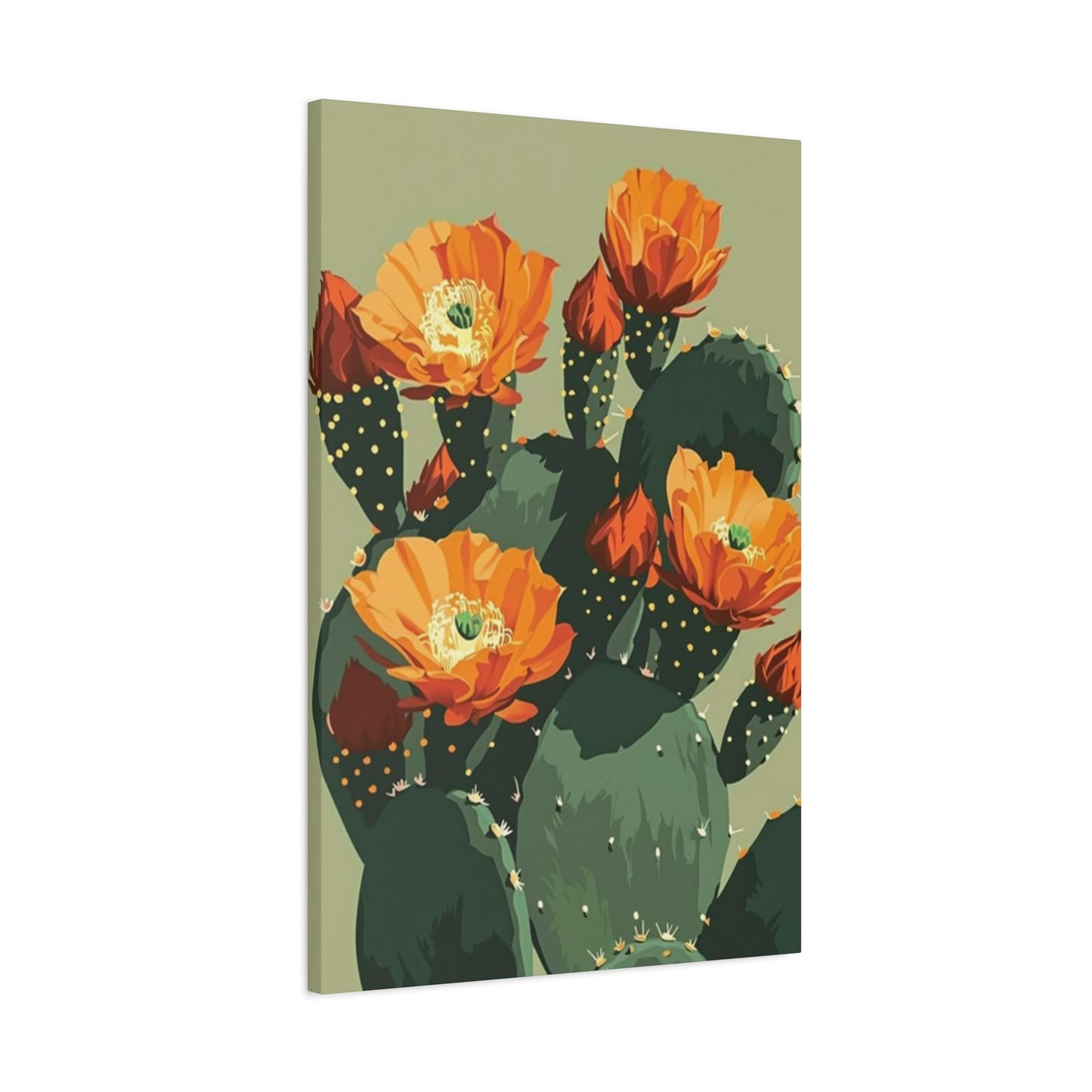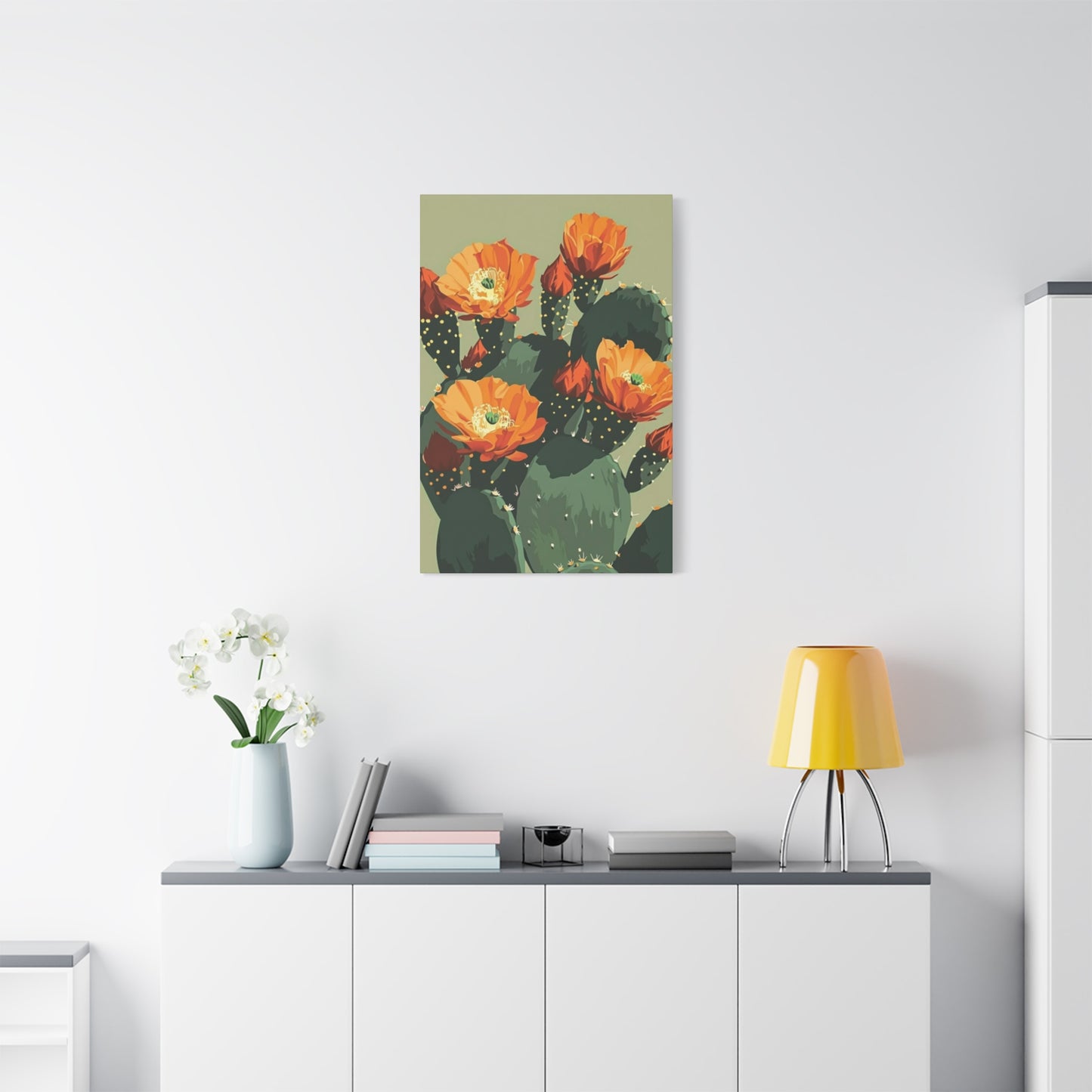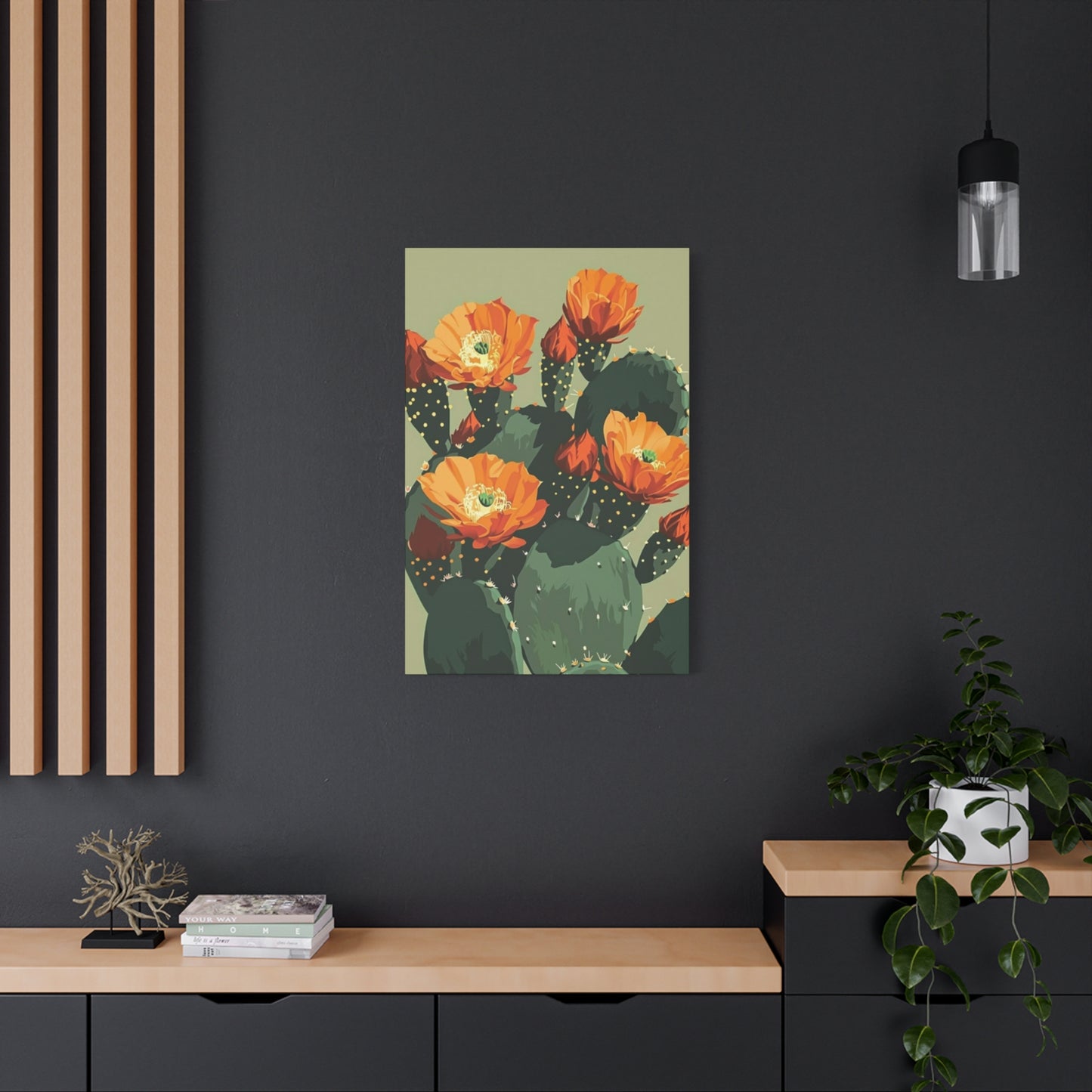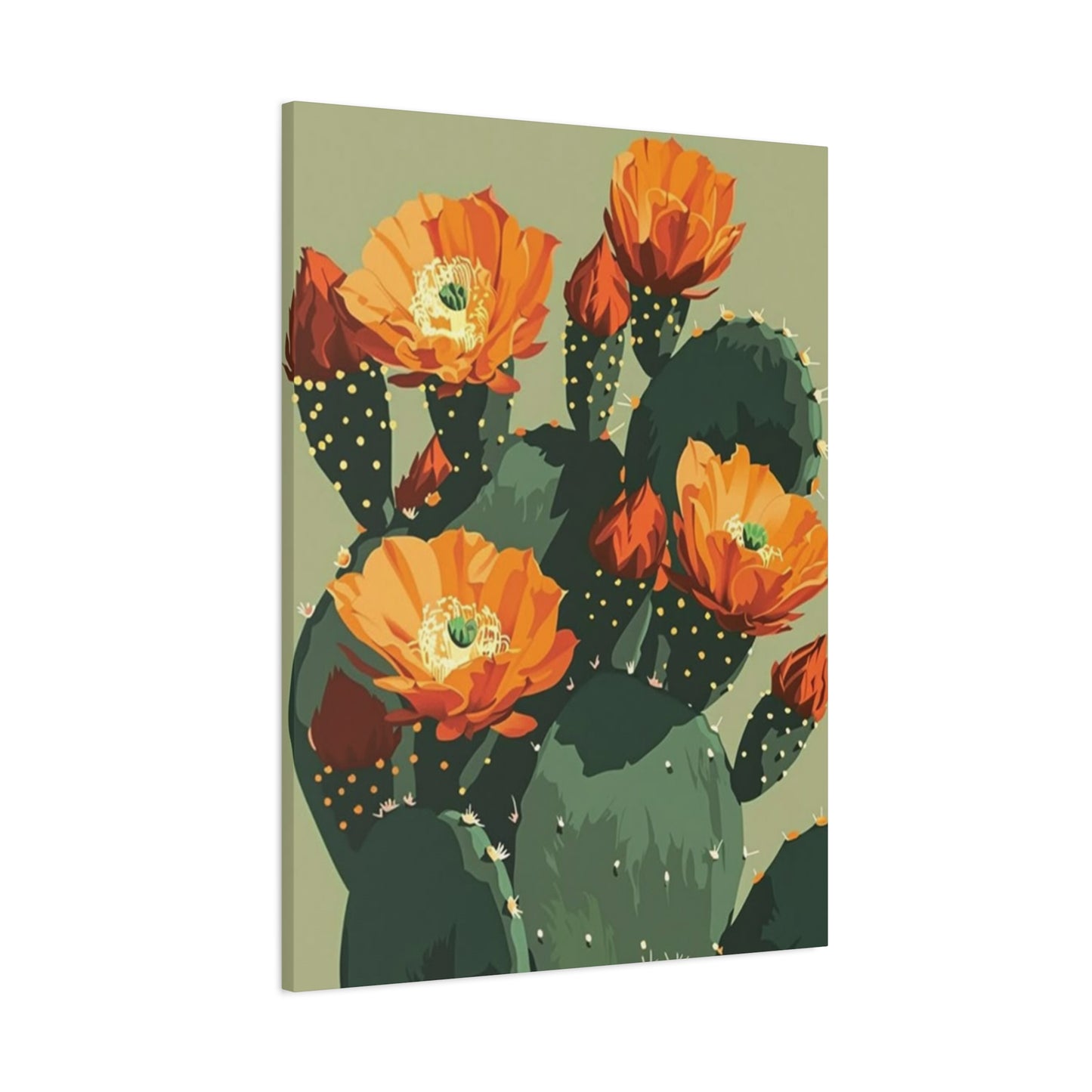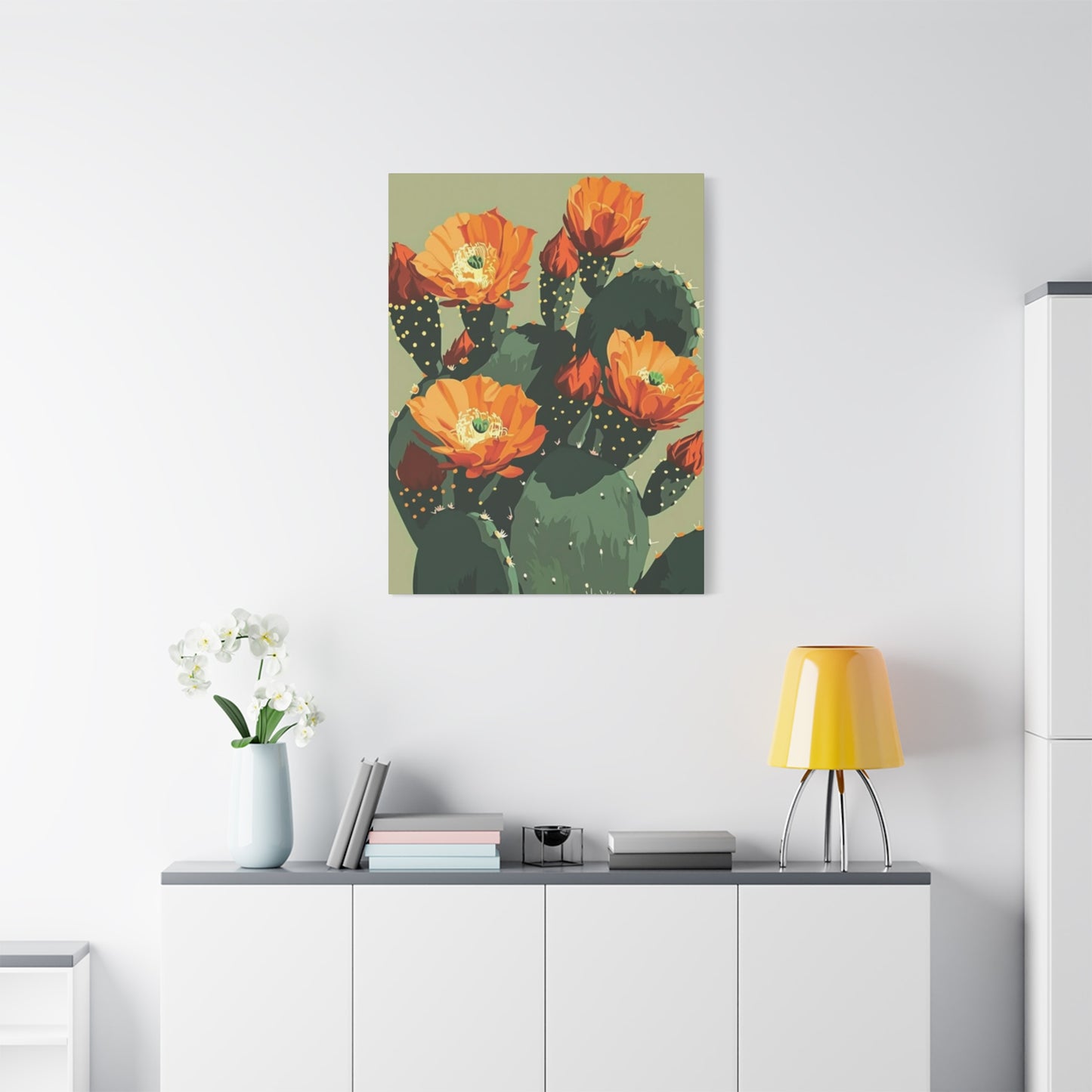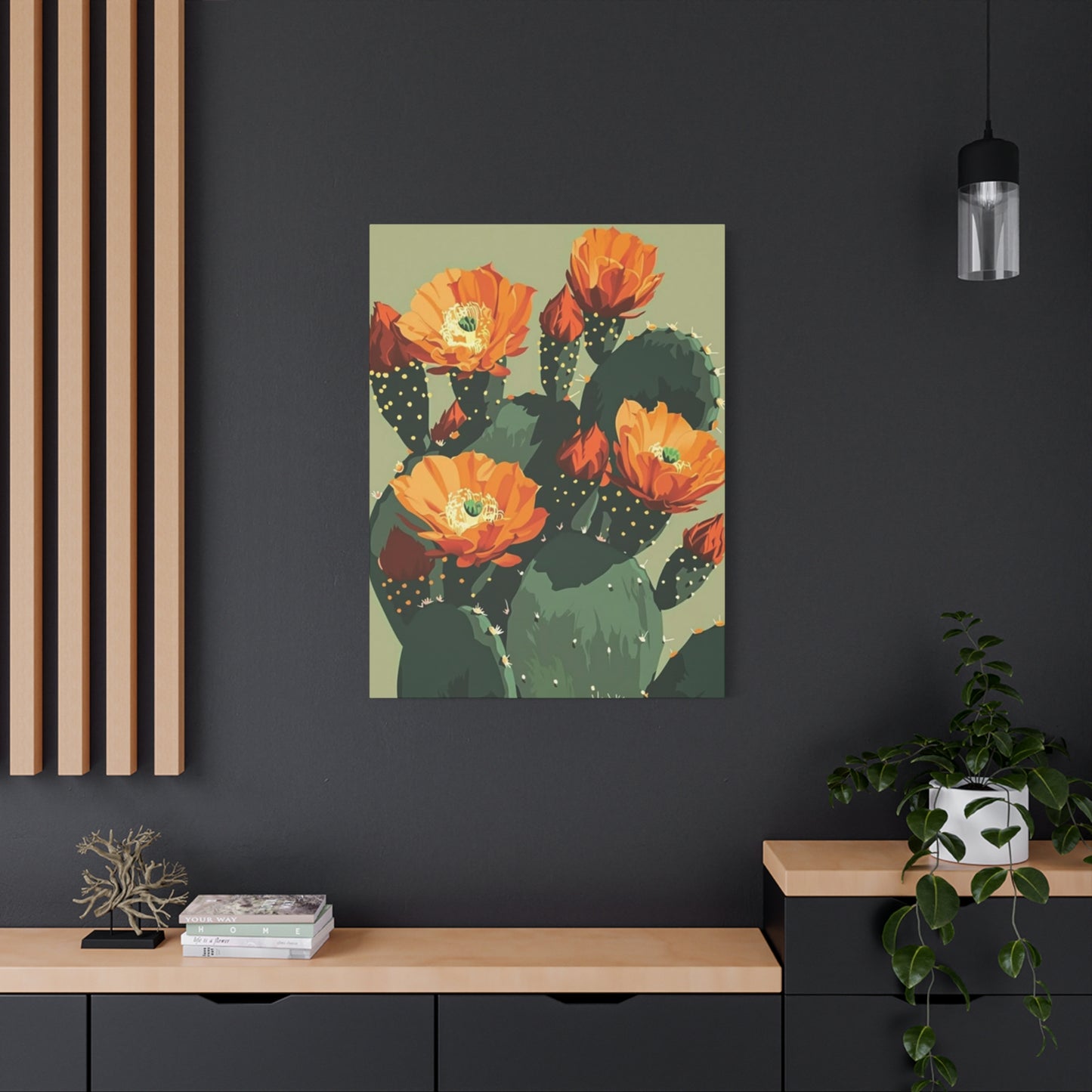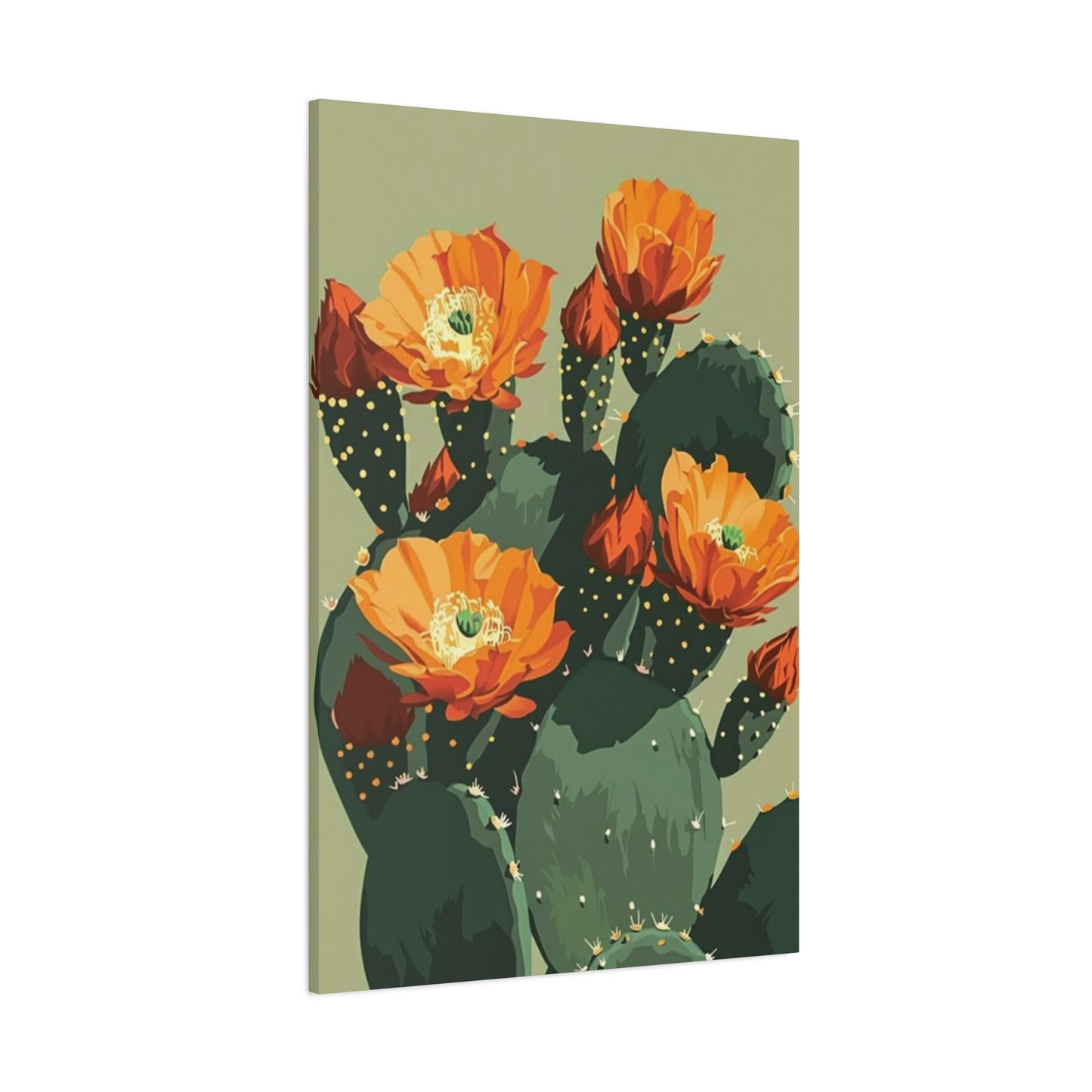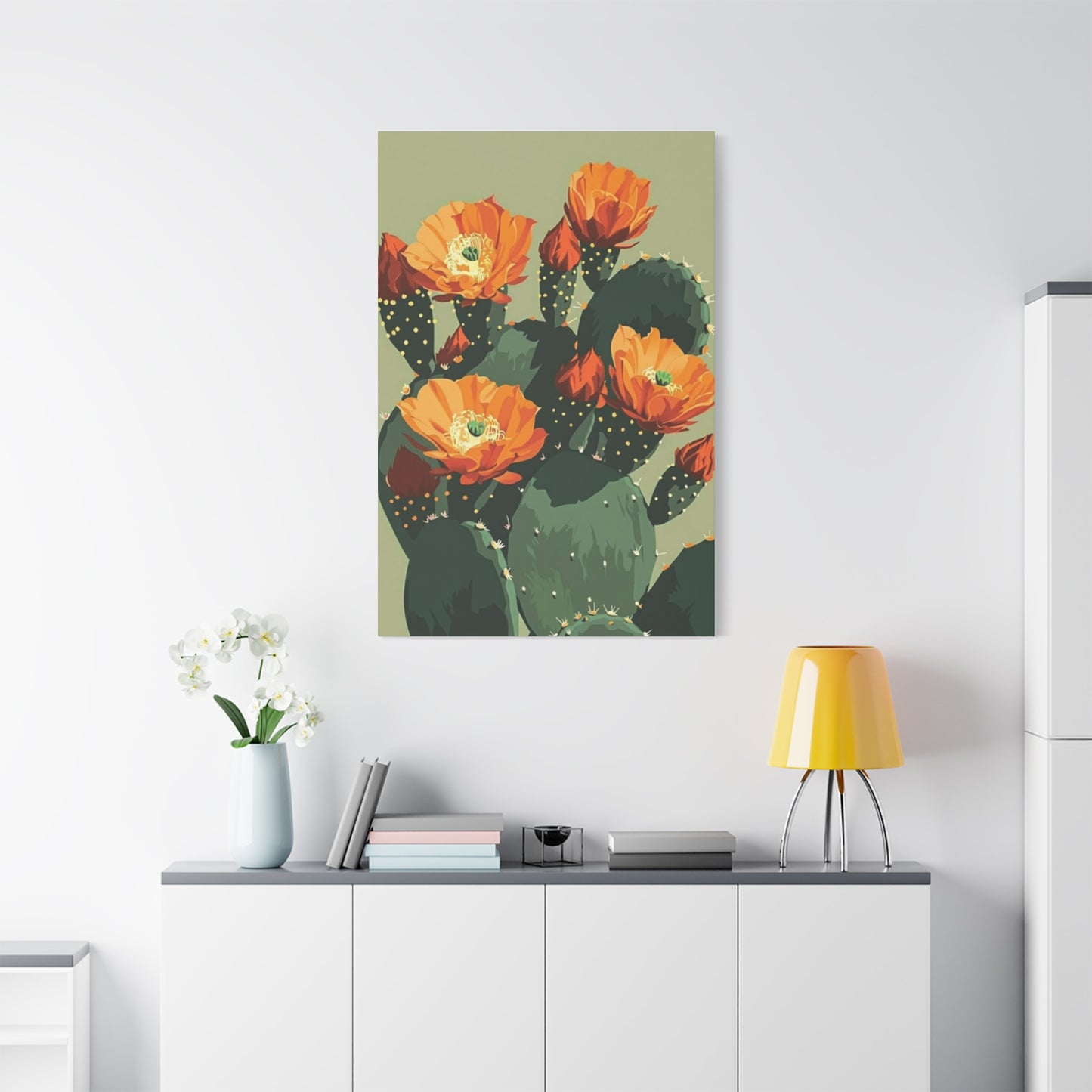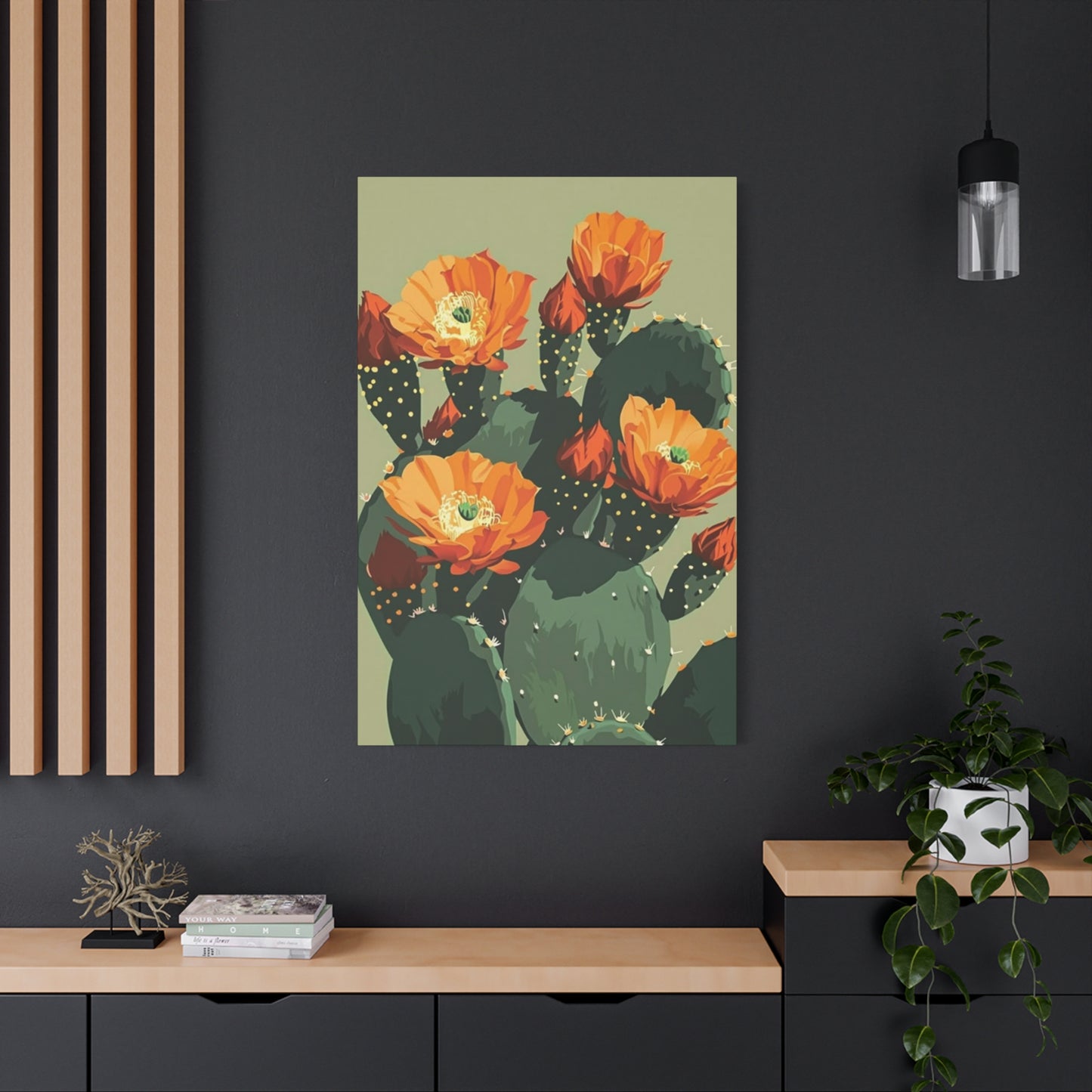Vibrant Flower on Cactus Wall Art: Decorating with Desert Beauty
The mesmerizing beauty of desert flora has captivated artists and homeowners alike for generations. When delicate, vibrant blooms emerge from thorny cactus stems, they create a stunning visual contradiction that speaks to nature's incredible diversity. This remarkable phenomenon has found its way into contemporary home décor through stunning canvas creations that celebrate the union of strength and delicacy.
Flowering cactus artwork brings an extraordinary element to any living environment, offering a perfect balance between rustic charm and sophisticated elegance. These remarkable pieces capture the essence of desert landscapes while providing a fresh, modern aesthetic that complements various decorating styles. The contrast between sharp spines and soft petals creates a visual narrative that draws viewers in, encouraging them to appreciate the unexpected beauty found in nature's most resilient plants.
Canvas prints featuring blooming cacti have become increasingly popular among homeowners seeking unique alternatives to traditional floral artwork. Unlike conventional flower paintings that might feel overly feminine or delicate, cactus bloom pieces offer a more balanced approach that appeals to diverse tastes and preferences. The sturdy, architectural nature of cacti combined with their surprising capacity for producing breathtaking flowers creates artwork that feels both grounded and ethereal.
The appeal of flowering cactus canvas art extends beyond mere aesthetics. These pieces often carry symbolic meaning, representing resilience, adaptability, and the ability to find beauty in challenging circumstances. For many, these artworks serve as daily reminders that strength and beauty can coexist, that harsh conditions often produce the most remarkable results, and that patience is rewarded with spectacular displays of natural wonder.
Modern printing technology has made it possible to capture every intricate detail of cactus blooms, from the subtle gradations of petal color to the precise texture of spiny surfaces. High-quality canvas materials ensure that these details remain vibrant and sharp for years to come, making these pieces worthwhile investments for any home decorating project.
Desert-Inspired Canvas Artwork for Contemporary Living Environments
Contemporary homes benefit tremendously from the addition of desert-themed artwork, particularly pieces that showcase the unexpected beauty of flowering cacti. These canvas creations bridge the gap between natural elements and modern design sensibilities, offering homeowners a way to incorporate organic beauty without compromising their carefully curated aesthetic.
The versatility of desert-inspired canvas art makes it suitable for virtually any room in the home. Living areas benefit from the calming presence of these natural scenes, while bedrooms gain a sense of tranquility from the peaceful desert imagery. Even kitchens and bathrooms can be enhanced with smaller cactus bloom pieces that add personality without overwhelming the functional aspects of these utilitarian environments.
Color palettes in flowering cactus artwork tend to be both sophisticated and welcoming. Earth tones form the foundation of most pieces, with warm browns, sandy beiges, and sage greens creating a neutral backdrop that works well with existing décor schemes. The flowers themselves introduce pops of color ranging from soft pastels to vibrant jewel tones, allowing homeowners to choose pieces that either complement or contrast with their current color schemes.
The scale of these artworks can vary dramatically, from intimate small pieces perfect for gallery walls to large statement pieces that command attention in spacious rooms. This variety ensures that every home can accommodate flowering cactus art, regardless of size constraints or decorating preferences. Large-scale pieces work particularly well in minimalist environments where fewer, more impactful decorative elements are preferred.
Texture plays a crucial role in the appeal of canvas cactus artwork. The canvas material itself adds visual and tactile interest, while high-quality printing techniques can simulate the varied textures found in actual desert plants. Some pieces incorporate raised printing or gel overlays that further enhance the textural experience, making the artwork feel more dimensional and engaging.
The lighting requirements for displaying desert-themed canvas art are relatively flexible. These pieces tend to look equally stunning in bright, natural light and softer, ambient lighting conditions. The earthy color palettes and natural subjects matter work well with various lighting schemes, making them adaptable to different room configurations and lighting preferences.
Striking Floral Displays on Thorny Desert Plants Canvas Art
The juxtaposition of delicate flowers blooming on hardy desert plants creates some of the most striking visual compositions in nature, and this dramatic contrast translates beautifully to canvas art. These pieces celebrate the remarkable ability of desert flora to produce stunning floral displays despite harsh growing conditions, creating artwork that is both visually appealing and conceptually meaningful.
Different cactus species produce remarkably diverse flowering displays, and canvas artists have embraced this variety to create collections that showcase the full range of desert blooming potential. From the bright yellow flowers of prickly pear cacti to the vibrant pink blooms of hedgehog cacti, each species offers unique visual opportunities that translate into distinctive artwork pieces.
The timing of desert blooms adds another layer of meaning to these canvas creations. Many desert plants bloom only briefly, making their flowering displays precious and fleeting events. Canvas art captures these temporary moments of beauty, preserving them in permanent form for ongoing enjoyment. This concept of capturing ephemeral beauty resonates with many viewers, adding emotional depth to the visual appeal of the artwork.
Color combinations in flowering desert plant art tend to be both harmonious and surprising. The muted tones of desert plants provide an excellent backdrop for the often bright, saturated colors of their blooms. This natural color pairing creates artwork that feels balanced and pleasing to the eye while maintaining enough contrast to remain visually interesting and dynamic.
The compositional possibilities for flowering cactus canvas art are virtually limitless. Some pieces focus on close-up views of individual blooms, highlighting the intricate details of petal structure and coloration. Others take a broader approach, showing entire plants in bloom within their desert environments. Still others create artistic interpretations that emphasize the emotional or symbolic aspects of desert flowering rather than literal representation.
The appeal of these pieces extends beyond their visual impact. Many viewers find themselves drawn to the story these artworks tell about resilience, adaptation, and unexpected beauty. In a world where we often focus on immediate gratification and obvious beauty, flowering desert plant art reminds us that some of the most remarkable displays of beauty require patience, perseverance, and the ability to thrive in challenging conditions.
High-Quality Canvas Prints Showcasing Desert Flower Beauty
The quality of canvas prints featuring desert flowers has improved dramatically in recent years, with advances in printing technology and materials science combining to produce artwork that rivals traditional painting techniques. High-resolution digital printing captures every nuance of color and detail, while premium canvas materials ensure durability and longevity that make these pieces worthwhile investments for any home.
Modern printing techniques can reproduce the subtle color gradations found in natural desert blooms with remarkable accuracy. The soft transitions from deep, saturated colors at the base of petals to lighter, more delicate tones at the edges are preserved with precision that brings these artworks to life. Even the most minute details, such as the fine textures of petal surfaces or the intricate patterns of cactus spines, are rendered with clarity that enhances the overall visual impact of the piece.
Canvas material selection plays a crucial role in the final quality of desert flower prints. Premium cotton canvases provide the ideal surface for reproducing the organic textures found in natural desert scenes, while synthetic blends offer enhanced durability and resistance to fading. The weave of the canvas itself contributes to the overall texture of the finished piece, with different weave patterns creating subtle variations in how light interacts with the printed surface.
Color permanence is a critical consideration for high-quality canvas prints, particularly for pieces featuring the vibrant colors often found in desert blooms. Professional-grade inks resist fading even when exposed to direct sunlight, ensuring that the brilliant yellows, deep magentas, and rich oranges of desert flowers remain true to their original intensity for years to come. UV-resistant coatings provide additional protection against color degradation, making these pieces suitable for display in bright, sunny rooms.
The printing process itself has been refined to achieve maximum color saturation and detail retention. Multi-pass printing techniques build up color density gradually, creating rich, deep tones that capture the full vibrancy of natural desert blooms. Specialized color management systems ensure consistency between the original artwork and the final printed piece, maintaining artistic integrity throughout the reproduction process.
Edge finishing techniques for canvas prints have also evolved to enhance both appearance and durability. Gallery-wrapped edges, where the printed image continues around the sides of the frame, create a finished look that eliminates the need for traditional framing. Alternative edge treatments, such as colored or patterned sides, can complement the main image while providing a clean, professional appearance that works well in contemporary home settings.
Balancing Strength and Delicate Beauty in Botanical Art
The inherent contrast between the rugged durability of desert plants and the delicate beauty of their flowers creates compelling artistic opportunities that resonate with viewers on multiple levels. This balance between strength and softness reflects many of the contradictions and complexities found in human experience, making these artworks emotionally engaging as well as visually appealing.
Desert plants have evolved remarkable survival strategies that enable them to thrive in some of the harshest environments on Earth. Their thick, waxy surfaces minimize water loss, while their spiny exteriors protect them from predators and provide shade for their growing tips. These adaptations create plants with distinctive architectural qualities that translate beautifully into artistic compositions, providing strong structural elements that anchor the overall design of the artwork.
When these hardy plants produce flowers, the contrast is often breathtaking. Delicate petals emerge from seemingly impenetrable defenses, creating moments of unexpected beauty that captivate observers. This transformation from protective fortress to generous display of beauty mirrors many human experiences, from overcoming personal challenges to finding joy in difficult circumstances.
The artistic interpretation of this strength-beauty balance varies significantly among different artists and artistic styles. Some pieces emphasize the protective aspects of desert plants, highlighting the formidable spines and thick flesh that enable survival. Others focus on the delicate beauty of the blooms, using soft colors and gentle compositions to emphasize the tender aspects of these remarkable displays.
Successful botanical art featuring flowering desert plants often finds ways to celebrate both aspects simultaneously. The viewer's eye might be initially drawn to a spectacular bloom, but closer examination reveals the fascinating survival mechanisms that make such beauty possible. This layered viewing experience creates artwork that rewards both casual observation and detailed study, making these pieces valuable additions to any art collection.
The symbolic resonance of strength-beauty balance extends beyond individual pieces to influence entire room designs. Homes decorated with flowering cactus art often reflect this same balance, combining strong architectural elements with soft, welcoming touches. The artwork serves as both decoration and inspiration, reminding inhabitants that true beauty often emerges from strength, resilience, and the ability to adapt to challenging circumstances.
Styling Guidelines for Desert Bloom Canvas Artwork
Incorporating flowering desert plant canvas art into existing home décor requires thoughtful consideration of color coordination, scale relationships, and stylistic harmony. These pieces work well with a variety of decorating approaches, from minimalist modern to rustic southwestern, but achieving the best results requires attention to several key factors that influence overall aesthetic success.
Color coordination forms the foundation of successful art placement. Flowering desert plant artwork typically features warm, earthy base tones accented by the brighter colors of the blooms themselves. These pieces work particularly well with neutral color schemes that allow the artwork to serve as a focal point. Warm whites, soft grays, and natural wood tones provide excellent backdrops that enhance rather than compete with the colors in the artwork.
Room lighting significantly impacts how flowering desert art appears in different settings. These pieces often look best in rooms with warm, natural lighting that mimics the harsh but beautiful light of actual desert environments. South-facing windows provide ideal conditions, but artificial lighting can be adjusted to achieve similar effects. Warm LED spotlights or track lighting can highlight specific pieces while maintaining the warm color temperature that complements desert themes.
Scale relationships between artwork and furniture require careful attention to achieve balanced, harmonious room compositions. Large pieces work well above substantial furniture items like sofas or dining tables, where they can command attention without overwhelming the surrounding elements. Smaller pieces are perfect for creating gallery walls or adding visual interest to areas that might otherwise feel empty or underdeveloped.
Grouping multiple pieces can create compelling visual narratives that tell more complete stories about desert environments and flowering cycles. Series of artworks showing different stages of bloom development or various species of flowering cacti can create educational as well as decorative displays. The spacing between grouped pieces should be consistent and proportional to both the size of the individual pieces and the scale of the wall where they are displayed.
Frame selection, when frames are used, should complement rather than compete with the artwork itself. Simple, clean-lined frames in natural materials like wood or metal work well with desert themes. The frame color should either blend harmoniously with the dominant colors in the artwork or provide subtle contrast that enhances the overall composition without drawing attention away from the artistic content.
Placement height is crucial for optimal viewing and room integration. Canvas art should generally be hung at eye level, typically with the center of the piece between 57 and 60 inches from the floor. However, this guideline may need adjustment based on ceiling height, furniture arrangement, and the specific proportions of both the artwork and the room where it will be displayed.
Budget-Friendly Options for Desert Flower Canvas Décor
Creating beautiful home environments with flowering desert plant artwork doesn't require substantial financial investment, thanks to the wide range of options available at various price points. Understanding the factors that influence pricing can help homeowners make informed decisions that balance cost considerations with quality expectations and decorative goals.
Print size significantly impacts pricing, with larger pieces generally commanding higher prices due to increased material and production costs. However, smaller pieces can be equally effective in many decorating situations, particularly when grouped together or used to accent specific areas of a room. Strategic use of smaller pieces can create impressive visual impact while maintaining budget constraints.
Canvas quality affects both price and longevity, but satisfactory results can be achieved with mid-range materials that offer good value without premium pricing. Cotton-poly blend canvases provide adequate durability and print quality for most home applications, while pure cotton options offer enhanced texture and longevity at moderate price increases. The key is matching canvas quality to intended use and budget parameters.
Print on demand services have revolutionized access to affordable canvas art by eliminating inventory costs and enabling competitive pricing. These services often offer frequent sales and promotional pricing that can significantly reduce costs for budget-conscious consumers. Timing purchases to coincide with these promotional periods can result in substantial savings without compromising quality.
Custom sizing options available through many print services can help optimize both cost and decorative impact. Rather than purchasing standard sizes that might not perfectly fit available wall areas, custom sizing ensures optimal use of both wall dimensions and budget allocations. Sometimes smaller custom pieces work better than larger standard sizes, resulting in both cost savings and superior decorative results.
Bulk ordering multiple pieces for comprehensive room makeovers or multi-room projects often qualifies for volume discounts that reduce per-piece costs. This approach works particularly well for series or collections of related pieces that tell cohesive decorative stories while providing economic advantages over individual purchases.
Digital download options represent the most budget-friendly approach to acquiring high-quality desert flower artwork. These files can be printed locally at photo service centers or home printers, giving consumers complete control over sizing, materials, and timing while minimizing costs. However, this approach requires more personal involvement in the production process and may not achieve the same quality levels as professional canvas printing services.
Captivating Desert Plant Canvas Prints for Visual Impact
The visual impact of flowering desert plant canvas prints stems from their ability to capture and concentrate the drama inherent in these remarkable natural phenomena. The stark beauty of desert environments, combined with the unexpected delight of blooming cacti, creates artwork that commands attention while providing ongoing visual interest through extended observation.
Dramatic lighting effects often play crucial roles in the most impactful desert plant artwork. The intense, directional lighting common in desert environments creates strong contrasts between highlighted and shadowed areas, resulting in compositions that feel dynamic and three-dimensional. These lighting effects are preserved in high-quality canvas prints, bringing the drama of desert light into indoor environments.
Color saturation in flowering desert plants often exceeds expectations, with blooms displaying intensities that seem almost artificial in their vibrancy. Canvas prints that accurately reproduce these saturated colors create immediate visual impact that draws viewers across rooms and holds their attention once they approach for closer examination. The contrast between these intense bloom colors and the more subdued tones of the plants themselves amplifies the overall visual effect.
Compositional techniques used in the most impactful desert plant artwork often employ principles of visual hierarchy that guide the viewer's eye through the piece in predetermined patterns. Leading lines created by plant stems or environmental features direct attention to focal points, usually the flowering areas, while secondary elements provide context and visual balance that supports the main subject matter.
Textural variety within individual pieces adds layers of visual interest that reward both casual viewing and detailed examination. The smooth, waxy surfaces of cactus pads contrast beautifully with the delicate textures of flower petals, while the geometric patterns created by spine arrangements provide additional visual complexity that keeps viewers engaged over time.
Scale relationships within the artwork itself can create powerful visual effects that translate well to canvas reproductions. Close-up views that fill the frame with a single spectacular bloom create intimate, almost abstract compositions, while broader views that show entire plants in their environmental context provide more narrative content that tells complete stories about desert life and survival.
The emotional impact of flowering desert plant artwork often exceeds what might be expected from botanical subjects. The story of resilience, adaptation, and unexpected beauty resonates with viewers on personal levels, creating connections between the artwork and individual experiences that enhance the overall visual impact and make these pieces memorable components of home décor.
Developing Southwestern Ambiance with Cactus-Themed Art
Southwestern decorating styles celebrate the unique beauty of desert environments, and flowering cactus canvas art provides an authentic foundation for creating these distinctive atmospheric effects. This regional aesthetic draws inspiration from the landscape, cultural traditions, and architectural elements found in the American Southwest, creating home environments that feel connected to this remarkable geographic region.
Color palettes associated with Southwestern design typically emphasize the warm, earthy tones found in desert landscapes. Terra cotta, sage green, warm tan, and deep turquoise form the foundation of these schemes, with accent colors drawn from the vibrant hues found in desert sunsets and flowering plants. Cactus bloom artwork naturally incorporates many of these traditional colors, making these pieces perfect anchors for broader Southwestern decorating themes.
Architectural elements common in Southwestern design, such as exposed wooden beams, adobe-style walls, and natural stone surfaces, provide excellent backdrops for flowering desert plant artwork. The organic curves and natural textures found in these architectural features complement the flowing lines and varied surfaces depicted in quality cactus art, creating cohesive design statements that feel authentic and well-integrated.
Material choices throughout Southwestern-themed rooms should emphasize natural elements that reflect the desert environment. Leather furniture, woven textiles, ceramic accessories, and metal accents in copper or wrought iron all work harmoniously with flowering cactus artwork. These materials create layered textures that echo the varied surfaces found in actual desert environments while providing comfortable, livable home atmospheres.
Lighting design in Southwestern-themed rooms should emphasize warm, golden tones that mimic the quality of desert sunlight. Table lamps with parchment shades, wrought iron fixtures, and strategically placed candles create ambient lighting that enhances the warm colors typically found in flowering cactus artwork. This lighting approach makes these rooms feel welcoming during evening hours while highlighting the artistic details of canvas pieces.
Plant selections for Southwestern-themed rooms should complement the desert themes established by the artwork without creating redundancy. Architectural plants with strong forms, such as snake plants, aloe varieties, or small palms, provide living elements that echo the structural qualities of cacti while adding fresh green colors that balance the often warm-toned artwork.
Furniture arrangement in Southwestern-themed rooms should create conversational groupings that encourage appreciation of the artwork while maintaining the relaxed, informal atmosphere associated with this regional style. Low, comfortable seating arranged to facilitate both conversation and art viewing helps create the laid-back ambiance that makes Southwestern decorating so appealing to many homeowners.
Highlighting Botanical Details in Canvas Flower Art
The intricate details found in flowering desert plants provide rich source material for canvas art that celebrates the complexity and beauty of botanical structures. Modern printing technology makes it possible to reproduce these details with remarkable fidelity, creating artwork that serves both decorative and educational purposes while satisfying viewers who appreciate careful observation of natural phenomena.
Flower structure varies significantly among different desert plant species, and skilled botanical artists exploit these differences to create diverse artistic experiences. The large, showy blooms of prickly pear cacti offer opportunities for artwork that emphasizes broad color fields and smooth petal surfaces, while the smaller, more intricate flowers of other species lend themselves to detailed studies that highlight complex structural relationships.
Petal characteristics provide particularly rich material for detailed botanical artwork. The waxy surfaces that help desert flowers conserve moisture create distinctive light-reflecting properties that skilled artists can capture to enhance visual impact. The subtle color variations within individual petals, from deep, saturated bases to lighter, more translucent tips, create opportunities for sophisticated color work that rewards close examination.
Reproductive structures within desert flowers often display remarkable adaptations to harsh environmental conditions, and these adaptations create visually interesting elements that add complexity to botanical artwork. Prominent stamens and pistils provide focal points within flower compositions, while their often contrasting colors create additional opportunities for artistic color work that enhances overall visual appeal.
The relationship between flowers and their supporting plant structures offers another layer of detail that enriches botanical canvas art. The way delicate blooms emerge from tough, spiny stems creates compelling visual contrasts that tell stories about adaptation and survival. These structural relationships provide compositional opportunities that create balanced, harmonious artwork while maintaining scientific accuracy.
Environmental context surrounding flowering desert plants adds additional layers of detail that can enhance the overall narrative content of botanical artwork. Background elements such as other plants, rock formations, or atmospheric effects like dust or heat shimmer provide context that helps viewers understand the remarkable nature of desert blooming while creating more complete, engaging compositions.
Seasonal timing considerations influence how flowering desert plants appear in different artworks, and these temporal aspects add meaning that extends beyond pure visual appeal. Early spring blooms emerging from winter-dormant plants tell different stories than late-season flowers appearing after summer rains, and skilled botanical artists use these seasonal cues to create artwork with enhanced emotional resonance.
Canvas Prints That Preserve Desert Environmental Wonder
The remarkable ecosystems of desert environments provide inspiration for canvas art that captures not just individual flowering plants, but entire environmental systems that support these unique displays of natural beauty. These comprehensive artistic approaches help viewers understand the complex relationships that make desert blooming possible while creating decorative pieces with enhanced educational and emotional value.
Ecosystem relationships in desert environments are often subtle but crucial to the survival and flowering of individual plants. Canvas art that incorporates these relationships helps viewers appreciate the interconnected nature of desert life while creating more complex, interesting compositions. The way different plant species support each other, compete for resources, or create beneficial microclimates provides rich material for artistic interpretation.
Weather patterns play crucial roles in desert flowering cycles, and artwork that captures or suggests these patterns helps viewers understand the environmental factors that trigger spectacular desert displays. The aftermath of rare desert rainstorms, when dormant plants burst into bloom, provides particularly dramatic subject material that combines environmental storytelling with stunning visual impact.
Geological features common in desert environments provide excellent compositional elements that enhance flowering plant artwork while adding context about the harsh growing conditions these plants must endure. Rock formations, sandy soils, and mineral deposits create textural variety and color contrast that support the main botanical subjects while telling more complete stories about desert survival.
Animal interactions with flowering desert plants add another layer of environmental complexity that can enhance canvas artwork while providing educational content about desert ecosystem function. Pollinators such as bees, birds, and bats create opportunities for dynamic compositions that show flowering plants as active participants in complex ecological relationships rather than isolated decorative elements.
Scale relationships between individual plants and their broader environmental context help viewers appreciate both the intimacy of individual blooms and the vastness of desert landscapes. Artwork that successfully manages these scale relationships creates pieces that work well in home decorating contexts while maintaining the dramatic impact of actual desert experiences.
Atmospheric effects common in desert environments, such as heat shimmer, dust hazes, or dramatic cloud formations, provide additional artistic opportunities that enhance the environmental authenticity of flowering desert plant artwork. These effects can be subtle suggestions that add atmosphere without overwhelming the main subject matter, or more prominent features that create dramatic, memorable compositions.
Gift Concepts: Flowering Desert Plant Canvas Artwork
Flowering desert plant canvas art makes exceptional gifts for a variety of occasions and recipients, combining universal appeal with personal meaning that creates memorable, lasting impressions. The symbolic richness of these pieces, combined with their decorative versatility, makes them suitable for diverse gift-giving situations and recipient preferences.
Housewarming gifts benefit from the welcoming, optimistic symbolism associated with flowering desert plants. These pieces suggest resilience, growth, and the ability to create beauty in challenging circumstances, making them perfect for friends or family members embarking on new living situations. The universal appeal of botanical subjects ensures that these gifts will be appreciated regardless of specific decorating styles or personal preferences.
Anniversary celebrations gain special meaning from flowering desert plant artwork that emphasizes themes of endurance, patience, and the rewards of long-term commitment. The way desert plants invest energy in spectacular but brief flowering displays mirrors the way successful relationships balance periods of quiet growth with moments of celebration and renewed beauty.
Graduation gifts that feature flowering desert plants send powerful messages about the rewards of perseverance and the importance of maintaining hope during difficult periods. The metaphor of plants that thrive in harsh conditions while producing remarkable beauty resonates with graduates facing uncertain futures and the challenges of establishing independent lives.
Business or professional gifts benefit from the sophisticated, non-controversial appeal of botanical artwork while conveying subtle messages about resilience, adaptability, and the value of patience in achieving success. Flowering desert plant pieces work well in office environments while avoiding the potential complications associated with more personal or controversial artistic subjects.
Wellness or recovery gifts find particular resonance in flowering desert plant imagery that celebrates survival, adaptation, and the emergence of beauty from difficult circumstances. These pieces can provide ongoing inspiration and hope for recipients facing health challenges or other personal difficulties while maintaining the positive, forward-looking attitude that supports recovery processes.
Art collector gifts that feature flowering desert plants offer unique additions to botanical collections while providing investment potential through quality materials and craftsmanship. Limited edition prints or pieces by recognized artists can provide both immediate enjoyment and long-term value appreciation that makes these gifts particularly thoughtful for serious art enthusiasts.
Custom sizing options available for many flowering desert plant canvas prints enable gift-givers to create personalized pieces that perfectly fit specific rooms or decorating needs. This customization capability makes these gifts feel more personal and thoughtful while ensuring practical utility that enhances long-term appreciation and use.
Enhancing Visual Depth with Desert Plant Canvas Textures
The textural richness inherent in flowering desert plants provides excellent opportunities for canvas art that emphasizes tactile qualities and visual depth. Modern printing techniques can simulate the varied surface qualities found in these remarkable plants, creating artwork that engages multiple senses while providing enhanced visual interest that rewards both casual observation and detailed study.
Surface variations within individual pieces create layered viewing experiences that reveal new details with continued observation. The contrast between the smooth, waxy surfaces of cactus pads and the delicate, often fuzzy textures of flower petals provides immediate textural variety that translates well to canvas reproductions. High-quality printing can capture these surface differences with remarkable fidelity, creating artwork that feels almost touchable.
Dimensional printing techniques now available for canvas production can actually create raised surfaces that simulate the three-dimensional qualities of actual plant structures. Gel overlays and specialized inks can build up flower petals and cactus spines to create artwork with genuine tactile interest that enhances the visual impact while providing unique sensory experiences not available in traditional flat printing.
Light interaction with varied textures creates constantly changing visual effects that keep artwork interesting throughout different lighting conditions and viewing times. The way light catches raised spine patterns or reflects off smooth petal surfaces creates subtle animation effects that make static artwork feel more alive and dynamic.
Color depth achieved through textural printing techniques can create remarkably realistic reproductions that capture not just the surface appearance of flowering desert plants, but also their essential character and presence. Multiple ink layers combined with textural elements can achieve color saturation and depth that rivals original artwork while maintaining the durability and affordability advantages of canvas prints.
Edge treatments for textured canvas pieces require special consideration to maintain the enhanced dimensional effects while ensuring proper mounting and display. Gallery wrapping techniques that continue textural elements around canvas edges create finished appearances that eliminate the need for traditional framing while maintaining the sophisticated look that quality artwork deserves.
Display considerations for textured canvas pieces may require modified lighting approaches that highlight the dimensional effects without creating harsh shadows that might detract from the overall composition. Angled lighting from multiple directions can enhance textural effects while maintaining even illumination of color areas that ensures balanced viewing experiences.
Brightening Home Environments with Botanical Canvas Art
The mood-enhancing properties of flowering desert plant artwork stem from both the inherent optimism of blooming subjects and the warm, welcoming color palettes typically associated with these pieces. The psychological impact of natural imagery, combined with the symbolic resonance of plants that create beauty despite harsh conditions, makes these artworks particularly effective for brightening home environments and improving daily living experiences.
Color psychology plays a significant role in the mood-enhancing effects of flowering desert plant artwork. The warm earth tones that dominate most pieces create feelings of stability and comfort, while the brighter accent colors found in bloom areas provide energy and optimism that can lift spirits and create more positive atmospheric effects in living environments.
Natural imagery has been shown to reduce stress levels and improve overall psychological well-being, making flowering desert plant artwork not just decorative but potentially therapeutic in its effects. The connection to nature provided by these pieces can be particularly valuable for urban dwellers or others who may have limited access to natural environments in their daily lives.
Room brightening effects extend beyond psychological impact to include actual visual effects that can make environments feel larger, lighter, and more welcoming. The often warm-toned backgrounds common in desert plant artwork reflect light effectively, while the varied colors and textures create visual interest that makes rooms feel more dynamic and engaging.
Seasonal effectiveness of flowering desert plant artwork makes these pieces valuable year-round decorative elements that can provide consistent mood enhancement regardless of weather conditions or seasonal changes outside. Unlike artwork that might feel inappropriate during certain times of year, botanical subjects maintain their appeal and relevance throughout all seasons.
Versatility in room applications means that the mood-enhancing benefits of flowering desert plant artwork can be distributed throughout the home rather than confined to single areas. These pieces work equally well in bedrooms, where they can provide peaceful, optimistic influences on sleep and wake cycles, and in active living areas where they contribute to social and family interactions.
Long-term satisfaction with botanical artwork tends to be higher than with more trendy or fashion-dependent decorative choices, ensuring that the mood-enhancing benefits continue over extended periods rather than diminishing as initial novelty wears off. The timeless appeal of natural subjects combined with quality materials creates decorative investments that provide ongoing returns in terms of daily enjoyment and psychological benefit.
Perfect Pairing: Floral Elements and Desert Plants in Art
The artistic combination of delicate floral elements with hardy desert plants creates compelling visual narratives that celebrate both strength and beauty while providing rich material for canvas artwork that appeals to diverse aesthetic preferences. This pairing represents one of nature's most striking examples of contrast and harmony, making it an ideal subject for decorative art that aims to capture complex emotional and visual effects.
Compositional balance between floral and structural elements requires careful artistic consideration to create pieces that celebrate both aspects without allowing one to overwhelm the other. Successful artwork manages to showcase the delicate beauty of desert blooms while maintaining appreciation for the remarkable adaptations that make such flowering possible. This balance creates artwork that tells complete stories rather than focusing on single aspects of these remarkable plants.
Color relationships between flowers and their supporting plant structures provide opportunities for sophisticated color work that creates visual harmony while maintaining enough contrast to keep compositions interesting and dynamic. The way bright bloom colors play against more subdued plant tones can create focal points that draw viewers into artwork while providing pathways for extended visual exploration.
Symbolic interpretation of the flower-plant pairing resonates with many viewers who see parallels between these natural phenomena and human experiences. The emergence of beauty from harsh conditions, the rewards of patience and persistence, and the value of inner strength all find expression in artwork that thoughtfully combines floral and structural elements.
Artistic techniques used to emphasize the flower-plant relationship vary significantly among different artists and styles. Some approaches use dramatic lighting to highlight the contrast between delicate blooms and tough plant structures, while others employ more subtle techniques that gradually reveal the relationships through careful observation. The choice of technique influences both the immediate impact and long-term viewing satisfaction of finished pieces.
Scale manipulation within individual artworks can create different narrative effects while highlighting various aspects of the flower-plant relationship. Close-up compositions that fill the frame with single blooms emerging from spiny backgrounds create intimate, almost abstract effects, while broader views that show multiple plants in environmental context tell more comprehensive stories about desert survival and flowering cycles.
Educational value inherent in artwork that accurately depicts flower-plant relationships makes these pieces valuable not just as decoration but as learning tools that can enhance understanding and appreciation of natural phenomena. This educational aspect adds depth to the viewing experience while creating conversation pieces that can engage visitors and family members in meaningful discussions about nature and survival.
Long-Lasting and Brilliant Desert-Themed Canvas Prints
The durability and color permanence of modern desert-themed canvas prints ensure that these decorative investments will provide years of enjoyment while maintaining their visual impact and artistic integrity. Advances in materials science and printing technology have created products that can withstand normal home environments while preserving the brilliant colors and fine details that make these pieces attractive decorative choices.
Fade resistance has improved dramatically in recent years, with professional-grade inks now capable of maintaining color intensity even when exposed to direct sunlight for extended periods. This improvement is particularly important for desert-themed artwork, which often features intense, saturated colors that might be vulnerable to degradation under less advanced printing systems. UV-resistant coatings provide additional protection while maintaining surface qualities that enhance rather than detract from artistic appearance.
Canvas longevity depends on both material quality and environmental conditions, but properly produced pieces can maintain their appearance and structural integrity for decades when properly cared for and displayed. Cotton and cotton-blend canvases provide excellent durability while offering the textural qualities that enhance the organic appeal of botanical subjects. Synthetic materials can offer enhanced durability in challenging environments while maintaining acceptable appearance standards.
Color vibrancy preservation techniques now standard in professional printing ensure that the brilliant yellows, deep magentas, and rich oranges common in desert flower artwork remain true to their original intensity throughout the useful life of the artwork. Multi-layer ink application and specialized color management systems work together to create color depth and saturation that rivals traditional painting techniques while offering superior longevity characteristics.
Environmental resistance capabilities of modern canvas prints make them suitable for display in various home environments, including areas with higher humidity levels or temperature fluctuations that might damage more delicate artwork. This environmental tolerance makes desert-themed canvas prints practical choices for bathrooms, kitchens, or other areas where traditional artwork might be problematic.
Cleaning and maintenance requirements for canvas prints are minimal, typically requiring only occasional dusting with soft, dry cloths to maintain optimal appearance. The protective coatings applied during production resist common household contaminants while preventing moisture absorption that could damage the underlying canvas or printed images. This low-maintenance characteristic makes canvas prints particularly attractive for busy households or commercial applications.
Investment value of high-quality desert-themed canvas prints stems from their combination of artistic appeal, durability, and timeless subject matter that maintains relevance across changing decorating trends. While not all prints will appreciate in monetary value, the enjoyment and satisfaction derived from quality pieces typically far exceeds their initial cost, making them worthwhile additions to home décor budgets.
Conclusion
Vibrant flower on cactus wall art offers a stunning way to bring the raw, striking beauty of the desert into interior spaces. These artworks blend the rugged textures of cacti with the surprising delicacy of blooming flowers—capturing a moment of contrast that is as symbolic as it is visually captivating. As a decorative element, this art form does more than beautify walls; it tells a story of resilience, transformation, and the unexpected grace found in harsh environments.
At the heart of this artistic style is the desert itself—an environment known for its extremes, yet teeming with life that adapts, survives, and occasionally flourishes in full color. The image of a cactus in bloom encapsulates this powerful duality. When brought into the home through art, it serves as a reminder of nature’s ability to thrive despite adversity, making it an inspiring and empowering choice for décor.
The aesthetic appeal of vibrant cactus flowers is undeniable. From the hot pinks and fiery oranges to the sunny yellows and deep reds, these blossoms pop dramatically against the muted greens and earthy tones of the cactus pads and spines. When translated into wall art, this color palette creates a striking focal point that can energize a minimalist room, warm up a modern space, or enhance a bohemian or Southwestern-themed interior.
More than just colorful decoration, these prints often evoke a sense of calm, clarity, and connection to nature. As part of the broader trend of nature-inspired and biophilic design, cactus flower art brings a grounding influence into indoor environments. It invites us to slow down and appreciate the subtle beauty in everyday things—a quality especially valuable in today’s fast-paced, screen-dominated world.
The versatility of cactus flower wall art also makes it a perfect choice for a variety of rooms. Whether placed in a living room, bedroom, hallway, or even a bathroom, it adds an element of surprise and personality. It can stand alone as a bold statement piece or be part of a larger gallery wall celebrating natural elements and earthy aesthetics.
In conclusion, decorating with vibrant flower on cactus wall art is more than a trend—it’s a celebration of desert beauty, natural resilience, and colorful contrasts. These artworks breathe life into contemporary interiors, offering not only visual pleasure but also a deeper symbolic message of blooming where you’re planted. For anyone looking to bring a touch of wild, radiant nature into their home, cactus flower prints are a powerful and elegant choice that speaks to both the heart and the eye.

















